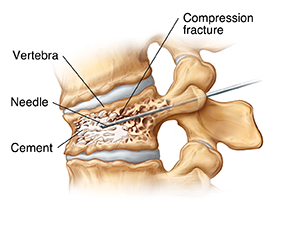Vertebroplasty
Fractures in the bones of the spine (vertebrae) can cause severe back pain and loss of movement lasting more than 6 weeks. Vertebroplasty is a procedure in which surgical cement is injected into the fractured vertebrae. This can make the spine more stable and ease back pain. The procedure is often done by a healthcare provider who specializes in radiology, orthopedic surgery, neurosurgery, or anesthesiology. However, an interventional radiologist (IR) or neuroradiologist most commonly does the vertebroplasty.
Before the procedure
Follow any instructions you're given for getting ready, including:
-
Follow any directions you're given for not eating or drinking before the procedure.
-
Tell your healthcare provider what medicines you take. This includes prescription and over-the-counter medicines, herbs, vitamins, or other supplements.
-
Tell your provider if you're pregnant, or if you think you could be pregnant.
-
Tell your provider if you're allergic to seafood, iodine, contrast medium (X-ray dye), or other medicines.
During the procedure
Here's what to expect:
-
You will change into a hospital gown and lie face down on an X-ray table.
-
An IV (intravenous) line is started to give you fluids and medicines. You may be given medicine through the IV to help you relax and make you feel sleepy.
-
A local anesthetic will be injected into your back to numb the area. Then, a needle is inserted into your back.
-
Contrast medium will be injected into the area. This helps show the needle and vertebrae clearly on X-rays. Using video X-ray images as a guide, the healthcare provider moves the needle to the vertebra to be treated.
-
A cement-like plastic material is injected through the needle into the vertebra. The procedure may be repeated on other vertebrae if needed.
-
The entire procedure may take 30 minutes to several hours, depending on how many vertebrae are being treated.

After the procedure
Here's what to expect:
-
You'll be asked to lie flat for 1 hour to 2 hours after the procedure while the cement hardens.
-
You'll most likely be able to go home in a few hours. Or you may need to stay in the hospital overnight.
-
You may feel an ache at the puncture sites for the next 24 to 48 hours. To ease this pain, use ice and pain medicines as directed.
-
Drink plenty of water to help flush the contrast medium from your system.
-
You may be able to go back to your normal light activities in a day or so. You may have to wait a few days or weeks for more vigorous activities.
Possible risks and complications
Every procedure has some risk. Possible complications after a vertebroplasty include:
-
Bleeding
-
Infection
-
Rib or vertebral fracture
-
Irritation of nearby nerves
-
Pain gets worse
-
Problems due to contrast medium, including allergic reaction or kidney damage
-
The surgical cement leaks, needing surgery to remove it (very rare)
-
Spinal cord or nerve root damage (very rare)
-
Blood clots in the lungs (in rare cases, cement can travel to the lungs)
© 2000-2024 The StayWell Company, LLC. All rights reserved. This information is not intended as a substitute for professional medical care. Always follow your healthcare professional's instructions.